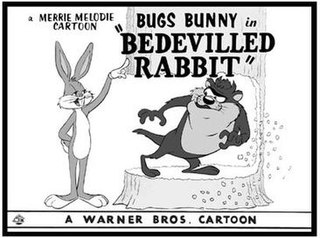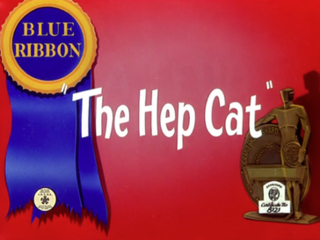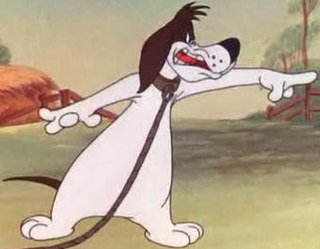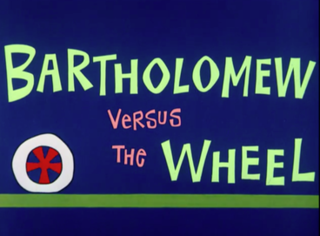Charlie Dog is an animated cartoon character in the Warner Brothers Looney Tunes series of cartoons. The character was featured in nine cartoons between 1941 and 1958. He is generally characterized as a friendly wise guy.

Cecil Turtle is a fictional character in the Warner Bros. Looney Tunes and Merrie Melodies series of films. Though he made only three theatrical appearances, Cecil has the unusual distinction in that he is one of the very few characters who were able to outsmart Bugs Bunny, and the only one to do so three times in a row and at the rabbit's own game. Cecil often gives Bugs the taunting nickname of "Speedy" when addressing the rabbit.

Tortoise Wins by a Hare is a Merrie Melodies cartoon released on February 20, 1943, and directed by Bob Clampett. It stars Bugs Bunny and Cecil Turtle. It is a sequel to 1941's Tortoise Beats Hare, with footage from said cartoon briefly shown at the beginning. It is also the first short to feature Robert McKimson's design of Bugs Bunny.

Cool Cat is a fictional cartoon character created by director Alex Lovy for Warner Bros.-Seven Arts Animation. He was the final star of the original Warner Bros. theatrical cartoons. His first appearance was in an eponymous short in 1967. He was voiced by Larry Storch. Robert McKimson took over as director for the last two cartoons in this series.

The Heckling Hare is a Merrie Melodies cartoon, released on July 5, 1941, and featuring Bugs Bunny and a dopey dog named Willoughby. The cartoon was directed by Tex Avery, written by Michael Maltese, animated by soon-to-be director Robert McKimson, and with musical direction by Carl W. Stalling. In a style that was becoming typical of the Bugs character, he easily outwitted and tormented his antagonist through the short, his only concern being what to do next to the dog.

An Itch in Time is a 1943 Warner Bros. Merrie Melodies cartoon, directed by Bob Clampett. The short was released on December 4, 1943 and features Elmer Fudd, with a dog and cat that look similar to Willoughby and Claude Cat.

Hare Remover is a Merrie Melodies cartoon starring Bugs Bunny and Elmer Fudd, released in 1946. The film was the second Bugs Bunny cartoon to be directed by Frank Tashlin, the first being The Unruly Hare (1945). It was also the last short Tashlin directed before leaving Warner Bros. in 1944 to direct live-action films. His animation unit was handed over to Robert McKimson upon his departure.

Rabbit's Kin is a 1952 Warner Bros. Merrie Melodies animated short directed by Robert McKimson and written by Tedd Pierce. The cartoon was released on November 15, 1952, and stars Bugs Bunny. The cartoon was animated by Charles McKimson, Herman Cohen, Rod Scribner, Phil DeLara and Keith Darling. The music was scored by Carl Stalling while the layouts and backgrounds were done by Robert Givens and Richard H. Thomas, respectively.

Walky Talky Hawky is a 1946 Warner Bros. Merrie Melodies theatrical short directed by Robert McKimson. The cartoon was released on August 31, 1946, and features Henery Hawk and Foghorn Leghorn. This is the first appearance of both Foghorn Leghorn and the Barnyard Dawg.

Bedevilled Rabbit is a 1957 Warner Bros. Merrie Melodies short directed by Robert McKimson. The short was released on April 13, 1957, and stars Bugs Bunny. In this cartoon, Bugs is lost in Tasmania, and has to deal with the Tasmanian Devil.
This is a list of all cartoons featuring Porky Pig. Directors are listed in parentheses.

The Hep Cat is a 1942 Warner Bros. Looney Tunes cartoon directed by Bob Clampett, written by Warren Foster, animated primarily by Robert McKimson, and set to a musical score composed by Carl W. Stalling. The short was released on October 3, 1942. This cartoon was the first Technicolor Looney Tunes short.

Barnyard Dawg is a Looney Tunes character. A feisty anthropomorphic basset hound, he is a friend and the archenemy of Foghorn Leghorn. He was created by Robert McKimson, who also created Foghorn, and was voiced by Mel Blanc. Dawg also feuds with other enemies as well like Henery Hawk, Daffy Duck and Sylvester. He appeared in 23 Golden Age–era Warner Bros. shorts.

Bugged by a Bee is a 1969 Warner Bros. Looney Tunes animated cartoon directed by Robert McKimson. It starred Cool Cat, and was the final cartoon from the original Looney Tunes/Merrie Melodies series to bear the Looney Tunes name, and the last from that era to be widely released. One more cartoon, Injun Trouble, would follow Bugged by a Bee, but it was in the Merrie Melodies series.

A Ham in a Role is a 1949 Warner Bros. Looney Tunes short starring the Goofy Gophers along with an unnamed dog who is based on stage/film actor John Barrymore. The cartoon was planned by Arthur Davis, but was finished and directed by Robert McKimson. It was released by Warner Bros. Pictures on December 31, 1949, but some sources list the release date as January 1, 1950. The cartoon draws heavily from the works of William Shakespeare, with its gags relying on literal interpretations of lines from Hamlet, Julius Caesar, Richard III, and Romeo and Juliet.

Now Hare This is a 1958 Warner Bros. Looney Tunes cartoon directed by Robert McKimson and written by Tedd Pierce. The short was released on May 31, 1958, and stars Bugs Bunny.
Odor of the Day is a 1948 Warner Bros. Looney Tunes cartoon directed by Arthur Davis. The short was released on October 2, 1948, and stars Pepé Le Pew. It is the only short in which he does not appear as a lover; it is also the only short in which he does not speak, save for one line at the end. The title is a play on the phrase "order of the day".

Bartholomew Versus the Wheel is a 1964 Warner Bros. Merrie Melodies cartoon directed by Robert McKimson. It was released theatrically on February 29, 1964.

It's Hummer Time is a 1950 Warner Bros. Looney Tunes cartoon directed by Robert McKimson and written by Warren Foster. The short was released on July 22, 1950. The cartoon stars a tuxedo cat who attempts to catch a hummingbird, only to get in the way of a bulldog who subjects him to various forms of torture for accidentally hurting and bugging him while doing so to the tune of Raymond Scott's Powerhouse, the cat seeming to know what's in store for him each time. All voice characterizations are performed by Mel Blanc.
















